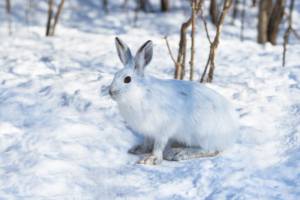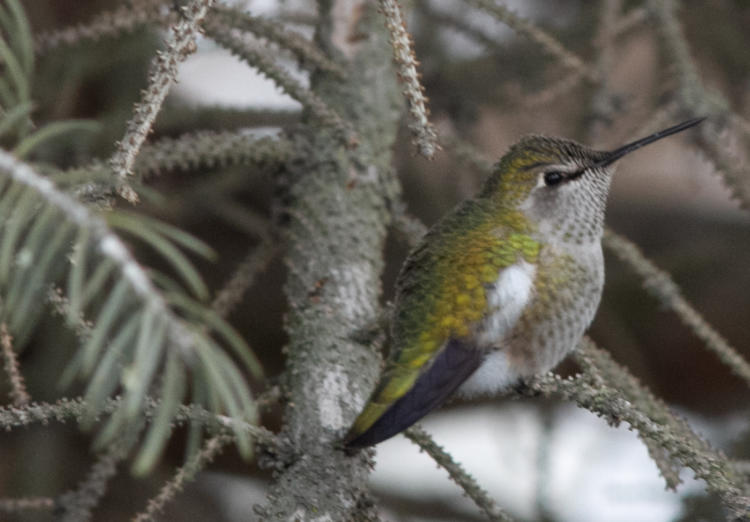Avoid the Predator!
Thanks to Nature Through the Seasons teacher Teresa Keenan for sharing this game idea.
Preface the game by discussing predator/prey relationships. What animals that live in your wild backyards are predators? Who are their prey? Use this discussion to guide the animals you choose for the game.
Materials
Blindfold, pine cone, spray bottle
To play:
- Have students form a circle.
- One student is the predator and stands in the middle of the circle blindfolded, with a pinecone beside them. All other students are the prey.
- The game begins when you point at one of the prey, who must then sneak up on the predator and steal the food (pinecone) without being detected.
- If the predator catches the prey (sprays them) they are dead, if the prey gets the food, they become the new predator.
- Continue to switch roles up to keep the game fun!
Winter’s Coping Strategies
Divide students into four groups representing the four winter coping strategies (eg. wood frog, snowshoe hare, hummingbirds, and squirrels). You could use different colour pinnies to identify each animal.
When you call out “Winter’s Coming” each animal group has to demonstrate how they survive:
- The Snowshoe Hares (chionophiles) bound around in the snow and camouflage (their fur turns white) to hide from predators.
- The Wood Frogs (hibernate) freeze completely solid and play dead
- The Hummingbirds (migrate) fly to the south (an area you have previously identified)
- The Squirrels (stay and cope) collect pine cones and other snacks to stash away in their midden for the winter
Play a few times, switching up the roles.

Bunnies and Trees
This game emphasizes the relationship between snowshoe hares and the trees that provide shelter and hiding spots. This is a version of ‘Hug Tag”. Have a few students be the “trees” and ask them to extend their arms to represent branches and spread themselves throughout the game area. The other students can be the “bunnies”. The teacher is the “hawk”. The bunnies hop throughout the game area until the teachers call out “the Hawk is coming” or “Here comes the Hawk”. The bunnies then run to a “tree” for shelter (one bunny per tree) and are safe. Switch the roles.
Migration Madness
Preface the game by talking about migration. What types of animals migrate? When do they migrate?
Establish a starting line and a finish line. Place a number of sticks equal to the number of students at the finish line The sticks represent migration survival. Line up the kids along the starting line and explain to them they are all hummingbirds beginning their long migration down south. Migration presents a myriad of challenges, from starvation, obstacles such as tall buildings, aeroplanes, bad weather, among others.
To play:
- Instruct students to fly from the starting line to the finish line, trying to pick up one of the sticks. The stick represents survival during migration. For the first round, allow all “hummingbirds” to survive.
- For the second round, present one migration challenge, taking away 1 or 2 sticks at the finish line. Students who do not pick up a stick have succumbed to the migration challenge presented.
- Continue to play, introducing more challenges (starvation, obstacles such as tall buildings, airplanes, bad weather, light pollution, etc.)
- When most of the hummingbirds have “died”, ask students for ideas on how they could help migrating birds. For each example, replace one of the migration survival sticks and continue play until all of the hummingbirds have safely made it to their southern destination.
Some examples of how we can help migrating birds include:
- Keep your cat indoors — this is best for your cat as well as the birds, as indoor cats live an average of three to seven times longer. Even well fed cats kill birds, and bells on cats don’t effectively warn birds of cat strikes. • Prevent birds from hitting your windows by putting up decals.
- Eliminate pesticides from your yard — even those pesticides that are not directly toxic to birds can pollute waterways and reduce insects that birds rely on for food.
- Create backyard habitat — if you have a larger yard, create a diverse landscape by planting native grasses, flowers, and shrubs that attract native birds. You will be rewarded by their beauty and song, and will have fewer insect pests as a result.
- Keep feeders and bird baths clean to avoid disease and prevent mosquitoes from breeding.
- Join a bird conservation group—learn more about birds and support important conservation work.










